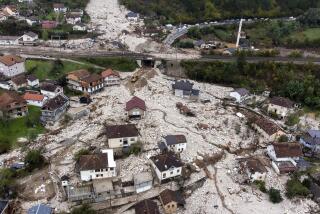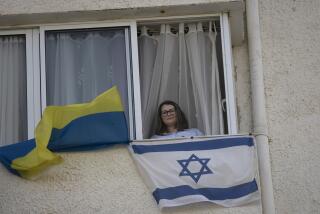Croatian Crowds Jeer Convoys of Fleeing Serbs : Balkans: ‘It was like a flood. It just carried us away,’ one refugee says of the exodus from Krajina. Atrocities are reported.
GLINA, Croatia — The lucky ones got to leave Wednesday. They had cars and gas. They lined up a few miles outside of town. And then, with the gloom of a funeral procession, they rolled toward the border.
These were the losers of the war in Croatia. A miserable motorcade of melancholy refugees stretching as long as the eye could see. They were Croatian Serbs running away to Serbia--young soldiers, old women, children and their parents.
“It was like a flood. It just carried us away,” said Mile, who spoke from his cramped automobile during a traffic jam by a cornfield. “Everyone was leaving, so we followed.”
Most had nowhere to go, but also no reason to stay. Humiliation and hatred lurked at every corner.
“Go! Go! Go!” gloating Croats jeered from the roadside. Hundreds lined the streets in heavy rain to witness the pathetic parade. Tomatoes splashed against windshields. Men spit into open windows. Children threw rocks. One woman waved an oversized broom, sweeping her despised neighbors out of town.
Four years ago, it was Croats who fled in disgrace when secessionist Serbs took control of the breakaway region, known as the Krajina, after Croatia declared independence from what was then Yugoslavia.
On Wednesday, memories were still fresh--and unforgiving.
“We knew a lot of them,” said Verica Sovic, a Croat along the route. “I am not sad to see them leave.”
The exodus marked the beginning of the end for nationalist Serbs in the Krajina. Most Krajina Serbs--perhaps as many as 150,000--have already poured into Serbia and Serb-controlled areas of Bosnia-Herzegovina, setting off what U.N. officials have described as a dire humanitarian crisis.
The convoy through here came from villages several miles to the west, where tens of thousands of refugees have been stranded because of continued fighting between the Croatian army and a band of die-hard rebel Serbs.
A U.N.-brokered cease-fire Wednesday eased tensions enough in the town of Topusko, where many refugees have been camped out, to allow the first motorcade to escape.
But with fighting still continuing in Dvor, the border town to the southeast, the only route out was 160 miles long--all through Croatia--to the Serbian border. Those with tractors, motorcycles and bicycles had to wait. They will ultimately be funneled into Bosnia, a far shorter journey, when the danger in Dvor subsides.
That could take time. The United Nations said Wednesday that five elderly refugees were executed in Dvor on Tuesday by men in military uniforms. The soldiers were reportedly embittered members of the Bosnian army who fought in the Croatian offensive against the Krajina Serbs.
According to the U.N., the soldiers shot their captives--all of whom were disabled or retarded--at close range. U.N. peacekeepers apparently witnessed the slayings.
The U.N. also said it had launched an investigation into a bombing attack Tuesday that may have targeted refugees near Dvor. Four bombs were dropped in the area, most likely by Croatian jets. Croatian officials have denied any involvement, but Western diplomats said there was little doubt they were Croatian aircraft. There was no information about casualties.
Meanwhile, in Washington, the Clinton Administration said it has obtained aerial photographs of mass graves near Srebrenica, the Muslim enclave in Bosnia that was overrun by Bosnian Serb forces last month.
Officials said the photos apparently confirm reports of mass executions of Muslim men and boys who were seized by Serb troops from columns of fleeing refugees.
A senior State Department official said the United States will present the evidence to the U.N. Security Council, perhaps as soon as today.
“We’ve got some evidence from sensitive sources that tend to corroborate accounts of atrocities against the Bosnian men and boys who were prevented from leaving Srebrenica,” State Department spokesman David Johnson said.
He declined to confirm that the evidence was obtained by spy aircraft, but other officials made it clear that the information included photographs.
One official said the photos showed “earth disturbances” that appeared to be fresh graves near the soccer stadium where the men and boys were initially detained. The official conceded that in other contexts such digging could indicate a construction project, but there is no building going on in war-shattered Srebrenica.
In a related development Wednesday, John Gannon, deputy director of the Central Intelligence Agency, told a congressional hearing that Croatian forces have committed atrocities in the Krajina but that the crimes were far less serious than those committed by Serb fighters in Bosnia.
“The Croatians have added measurably to the humanitarian disaster in the region,” Gannon said. “But so far there have been no reports of the massive, systematic abuses we have seen in Bosnia. . . . The ‘ethnic cleansing’. . . [by] the Bosnian Serbs [is] unrivaled in scale and intensity.
“In many cases,” he added, the Serb forces “secured the area around a town and fired artillery or tank rounds into the area to terrorize the population, according to a variety of reports. Similar reports of terror, rape, torture and murder have emerged since the attacks last month by Bosnian Serb forces on the eastern enclaves of Srebrenica and Zepa.”
In Glina, for those not trapped by the fighting, the emotional price of getting out of town Wednesday was high. The route through here passed along a deserted road that was fraught with terror. On the weekend, hundreds of horrified Serbs, frantic to escape the approaching war, loaded their life’s possessions into cars, wagons, trailers and tractors.
But the war moved too fast. It caught up with them. And overtook them. No one Wednesday could say exactly what happened, but the wreckage left behind was silent testimony to tragedy.
Cars were pushed off the road. Tractors toppled on their sides. Debris was strewn everywhere--shoes, toys, soft drinks, bedding, washing machines, a cane.
“People were rushing out in fear. Their fear was stronger than their good sense,” said Katica Batina, a tearful Croat who stayed behind but whose Serbian husband and son were among those who fled. “It happened in a moment. I didn’t even give them any sandwiches.”
The horrible scene was only the prelude to the grim journey Wednesday. Cars broke down along the route. Some had to be abandoned. Others were hastily repaired. In one case, a frantic family hitched its disabled vehicle to the back of an open-bed truck. With traffic pressing from behind, they pushed elderly family members up a steep ladder into the truck.
“We don’t know where we are going,” said Milica Natalic, who stayed in the car to steer.
At least Natalic had her family. That couldn’t be said for Mile, a 48-year-old Croatian Serb who lost track of his two sons in the rush to leave.
Mile was traveling with his father, wife and three of his brother’s children. They had slept three nights in the car, living on candy bars and biscuits. They had managed to squeeze a radio and a few sacks of clothing in the trunk; otherwise, they left empty-handed.
They were told that the convoy was destined for Belgrade, but they had no plans beyond that. It is one day at a time now, Mile explained. He can’t manage any other way.
“I don’t understand anything right now,” he said, waving goodby as he rolled up his window to keep out the rain.
Times staff writer Norman Kempster in Washington contributed to this report.
More to Read
Sign up for Essential California
The most important California stories and recommendations in your inbox every morning.
You may occasionally receive promotional content from the Los Angeles Times.










